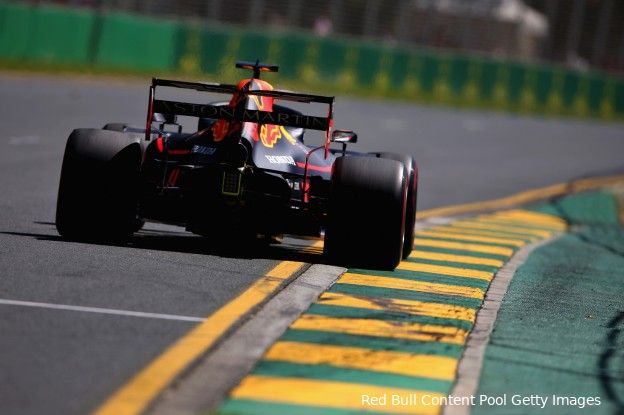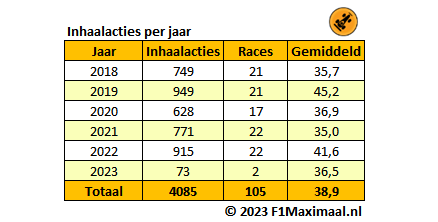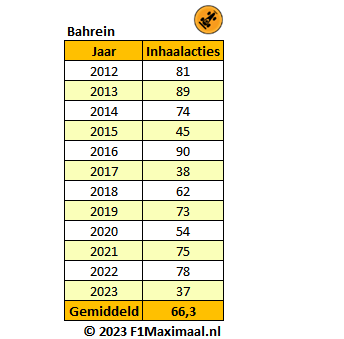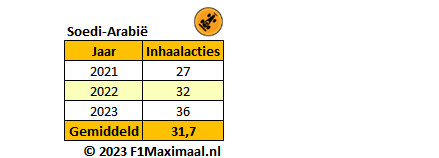
In 2022, a new technical regulation was introduced in Formula 1, which should enable drivers to follow and overtake their predecessors more easily. There was even talk of a first step towards abolishing DRS use. Several teams, especially Mercedes, suffered from porpoising last year, so the rules were changed again this year. After the Saudi Arabian Grand Prix, Max Verstappen and some colleagues indicated that it was more difficult to follow another car. F1Maximum investigated whether the statistics confirm that suspicion and we are back at square one.
As early as 2017, the FIA set up a working group led by Ross Brawn to investigate how Formula 1 could make it easier to follow another car. Five years later the time had finally come; the new rules were introduced, and the teams entered the opening race in Bahrain with completely different cars, the biggest ever aerodynamic rule changes, it was said.
In the opening phase of the season, the impact of the new technical rules was positively welcomed, which indeed seemed to have promoted overtaking. There was one problem: several teams suffered a lot from porpoising, the bouncing of the car over the straights. Mercedes’ Toto Wolff in particular responded to the safety element in this, and the FIA eventually tacked: the rules had to be adjusted again before 2023. This year the floor edge must be 15 millimeters higher than last year, and the narrowest part of the diffuser also had to be raised.
After the second Grand Prix of the season in Saudi Arabia, several drivers reported that following another car had become more difficult. Verstappen said it felt like he was driving into a headwind, while Ferrari driver Carlos Sainz said it was clearly more difficult to drive in dirty air than last year, and it almost felt the same as the old cars, which were up to 2021 were used. F1Maximum delved into the numbers and looked for first indications to see if this is indeed the case.
Did the new rules in 2022 have the desired effect?

Table 1 summarizes the figures for the past five years plus the first two races of the current season. Only overtaking actions that took place outside the pit lane were considered, and overtaking actions from the first lap were removed. In addition, all overtaking actions from the sprint races have been removed from the data in order not to influence the average per Grand Prix.
If we first look at the difference between 2021 and 2022, we see that more was indeed caught up in 2022, although 2019 remains the leader in this list. From 2018 to 2021, an average of 38.2 overtakings were made per race. In 2022, that rose to 41.6 overtakes per race, an increase of 8.8% compared to the average of the previous four years. The number of overtaking actions did increase, but 8.8% seems to be a fairly limited effect given the amount of work that has been put into the new regulations.
However, the provisional average of 2023 does not bode well. Based on the first two races of the season, any effect of the 2022 rules seems to have been nullified. The 36.5 overtakes per race so far means a decrease of more than 12% compared to last season and is even 5.5% lower than the average over 2018-2021. Of course, this data is only based on two races, but an extra worrying factor is that the Bahrain Grand Prix in particular is known as a race where a lot of overtaking is normally done.
The telling figures from Bahrain
In each of the years studied, 2018 to 2022, the Bahrain Grand Prix was among the three races with the most overtaking. On average, nowhere is more overtaken than in Bahrain, so if it doesn’t work in Bahrain, then where? Based on that statistic, the numbers in Table 2 don’t exactly paint a rosy picture for the rest of the season.

The 2020 Sakhir Grand Prix is not included in the figures from Table 2, as it was held in a different circuit configuration in the corona year. Furthermore, the figures are used from 2012, because in 2010 a different layout was also used, and the race was canceled in 2011 due to the dire political situation in Bahrain during the Arab spring. Since 2012, there has never been so little overtaking as this year. In both 2021 with the old rules and last year in 2022 with the new rules, drivers overtook more than twice as often as during the current season’s edition.
The only mitigating factor in these figures is the fact that the DRS zone on the straight was shortened by 80m this year, but with a straight of 1,090m that should have a limited impact. If it is also the case in 2023 that Bahrain can be found in the three races with the most overtaking actions, then that does not bode well for the remaining races of the current Formula 1 season.
What was the situation in Saudi Arabia?
While Bahrain gives a very clear indication that overtaking has become more difficult this year, the figures from Saudi Arabia offer a somewhat different picture. The race on the Jeddah Corniche Circuit was only held for the third time this year, making it more difficult to make a good comparison. The figures from Saudi Arabia can be found in Table 3.

Table 3 shows that the number of overtakes in Saudi Arabia has increased slightly since the first edition of the event. It must be said that this also depends slightly on the method. Using a different method, the German Auto, Motor und Sport saw a decrease from 38 last year to 33 overtaking this year. In any case, a clear trend cannot be discovered from the figures of the Saudi Arabian Grand Prix.
What does play a role in these figures are the starting positions of top drivers Max Verstappen and Charles Leclerc. Verstappen had to start the race in fifteenth after qualifying problems, while the Monegask was forced to start in twelfth due to an engine-related grid penalty. Verstappen in particular was responsible for a serious part of the total number of overtakes with eight overtakes. Aside from the statistics, both Verstappen and both Ferrari drivers spoke after the race about how difficult it was to overtake, three drivers whose opinions cannot easily be ignored.
Whether the Bahrain Grand Prix was indeed an indication that we can expect fewer overtakes for the rest of the season remains to be seen. If that is indeed the case, it will be interesting to see whether the FIA will once again force the teams to make far-reaching technical changes to reverse this effect. In any case, the Australian Grand Prix is traditionally a race where very little overtaking is done, although the changes to the circuit last year seemed to have improved the situation somewhat.
By: Mark Hanselman




